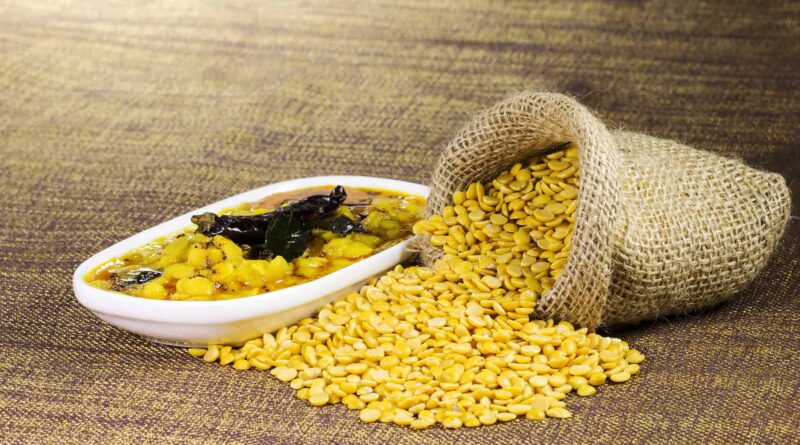Not enough rain in pulses heartland: Why arhar could face the heat this year
By Parthsarthi Biswas
Even as Northwest India reels under excess rain, the situation is quite the opposite in the two major pulses-growing states of Maharashtra and Karnataka.
According to the Union Agriculture Ministry, the total area sown under pulses in the current kharif season from June till July 9, at 46.32 lakh hectares (lh), was 17.9% lower than the 56.43 lh during the corresponding period of last year. The acreage declines have been particularly sharp for Maharashtra (9.46 lh to 3.83 lh) and Karnataka (12.97 lh to 6.02 lh), while less in Madhya Pradesh (9.53 lh to 8.61 lh), Uttar Pradesh (3.69 lh to 2.70 lh) and Telangana (1.11 lh to 0.80 lh). On the other hand, the progressive coverage in Rajasthan, at 22.38 lh, has been higher compared with 16.82 lh for the same period of 2022.
Impact of deficient rainfall
The overall shortfall in pulses area is a result of cumulative rainfall during the ongoing monsoon season from June 1 to July 11 being 23% below the historical normal average for this period in Maharashtra, 26.2% in Karnataka and 30.9% in Telangana. This is as against a rainfall surplus of 155.4% recorded by Rajasthan during this period.
Within pulses, the real acreage lag is in arhar or tur (pigeon-pea), almost halving from 19.46 lh to 10.32 lh. This isn’t surprising, given that the rainfall deficiency has been even more in North Karnataka (36.7%), Marathwada (39.4%) and Vidarbha (30.6%), which have large arhar-growing tracts. Area under urad (black gram) hasn’t fallen much (from 13.89 lh to 12.41 lh), while actually going up for moong (green gram, from 16.75 lh to 17.75 lh).
Moong acreage has increased mainly thanks to Rajasthan, which has received excellent rain. The state has registered higher area under both moong (10.34 lh to 15.03 lh) and urad (1.59 lh to 2.68 lh). The country’s biggest urad producer, MP, has seen only a marginal area dip from 6.98 lh to 6.85 lh.
Arhar is the problem
Moong and urad are relatively short-duration crops, ready for harvesting within 65-75 days after sowing during kharif. In contrast, arhar grows over 150-180 days and is harvested only in December-January, unlike September for the other two.
Arhar is mostly cultivated as an inter-crop with soyabean, cotton and even moong and urad. Farmers who inter-crop arhar with soyabean would typically sow both after mid-June with the onset of the monsoon. The soyabean crop is harvested in 90-100 days (by end-September/early-October), while the market arrivals of arhar start only after mid-December.
Maharashtra farmer Rajkumar Bhosale has sown arhar on one row after every three rows of soyabean in 12 acres. The 45-year-old, who farms 20 acres in Bombali village of Latur district, would ideally want to grow arhar along with soyabean on his entire holding.
The reason: Arhar is now trading in Latur, India’s biggest wholesale market for the pulse, at Rs 9,500-10,000 per quintal. That’s well above its government-declared minimum support price (MSP) of Rs 7,000. “At these prices, who wouldn’t want to take this crop?” said Bhosale, who last year limited his arhar area to just 5 out of the 20 acres. Bhosale’s plans are, however, constrained by the monsoon. Normally, he would have started sowing towards mid-June. This time, he could sow only during June 28-30 and, that too, cover just 12 acres: “I am waiting for it to rain enough to cover the balance 8 acres.”
Desperate for rain
Arhar is a largely rain-fed crop, with hardly 8% of its total area coming under irrigation (it’s less than 2% in Maharashtra and about 12.5% in Karnataka). Its relatively long duration of 5-6 months requires at least a couple of good showers.
“We generally recommend that farmers should sow only after about 100 mm of rainfall is received. Adequate soil moisture is necessary both for germination and vegetative growth (roots, stems and leaves) during the first 40-45 days. Rain is also needed prior to flowering and pod formation,” said Changdev Wayal, senior pulses scientist at the Mahatma Phule Agricultural University in Rahuri, Maharashtra.
The university’s recommended cut-off date for sowing of arhar is July 10-12. “It can be stretched up to July 30, but then the crop will not get enough time for vegetative growth. That would also make it more vulnerable to pest and disease attacks, reducing yields by 10% or more,” added Wayal.
The sowing window is closing fast for farmers like Bhosale. Another farmer, Ganesh Nanote has managed to sow arhar on one after every five rows of cotton in his entire 10-acre holding. For this farmer from Nimbhora village in Akola district, Vidarbha, the main concern is yields. With kapas (raw un-ginned cotton) prices collapsing to near MSP levels from last year’s all-time-highs, he has put all hopes on arhar. But if rainfall deficiency results in moisture stress, particularly towards the terminal pod-filling stage, those hopes might not materialise.
This article has been republished from The Indian Express

